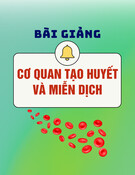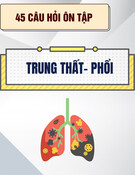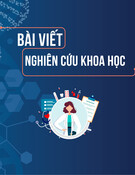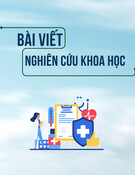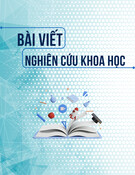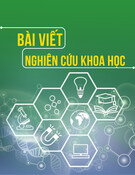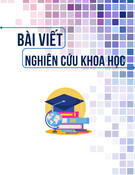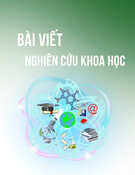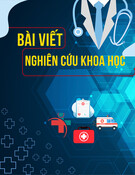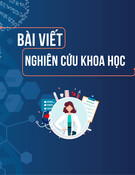
72
Journal of Medicine and Pharmacy, Volume 12, No.07/2022
Peer assessment approach to promote clinical communication skills in a
blended learning course of early clinical exposure
Le Ho Thi Quynh Anh1, Nguyen Thi Cuc1, Nguyen Thi Thanh Huyen1, Ho Anh Hien1,
Vo Duc Toan1, Nguyen Minh Tam1, Le Van Chi2*
(1) Family Medicine Center, Hue University of Medicine and Pharmacy, Hue University, Vietnam
(2) Internal Medicine Department, Hue University of Medicine and Pharmacy, Hue University, Vietnam
Abstract
Background: Blended learning offers opportunities for the complexity of learning in clinical education.
Student peer assessment is widely used as a form of formative assessment in early clinical exposure programs,
especially clinical communication skills training. This study aimed to describe clinical communication skills
competencies of second-year students and to identify the relationships between peer and faculty assessment
of communication skills in a blended learning program format. Methods: A total of 474 second-year general
medical students and dental students participated in the study. Peer and lecturer assessment forms with
a 5-point Likert scale according to the Calgary-Cambridge guide format were used to evaluate students’
performance of basic communication skills, relationship building, and history taking. Pearson’s correlation
coefficients and paired t-test were applied. A p-value < 0.05 was considered statistically significant. Results:
Most of students were rated at distinction level (score at 7-8.4) in communication skills. Mean of the overall
score by peer and faculty assessment were 7.46 ± 1.03 and 7.17 ± 0.68, respectively. Peers rarely provided
negative ratings on subcategories of communication skills. Skills of understanding the patient’s perspectives
and gathering information were the most reported skills needed to improve among students. Significant
positive correlations were found between peer and faculty evaluations for building relationship, establishing
initial rapport, and gathering information domains (p < 0.01). Students tended to grade their colleagues
higher for building relationship (3.88 ± 0.62) and establishing initial rapport domains (3.72 ± 0.61) than other
domains, meanwhile, teachers tended to grade building relationship (3.80 ± 0.55) and gathering information
domains (3.64 ± 0.38) higher than other domains. Conclusion: The findings suggest that student peer
evaluation can be valuable for clinical education. As part of a formative assessment, it can be also used
for faculty to evaluate students’ clinical communication skills performance in innovative medical education
programs.
Keywords: peer assessment, clinical communication skills, practice of medicine, early clinical practice,
blended learning.
Corresponding author: Le Van Chi, lvchi@huemed-univ.edu.vn
Recieved: 2/11/2022; Accepted: 28/11/2022; Published: 30/12/2022
1. INTRODUCTION
Communication has been identified as one of
the core clinical skills for all healthcare providers,
especially primary care physicians. Primary care
provides the first contact point services which
follow a patient-centered approach, maintaining
relationship with the patient from time to time
through effective communication, and solving
patients’ health problems holistically which covers
physical, psychological, social, and cultural aspects,
and other shared concerns. Towards global trends
in medical education, since 2015, the Vietnam
Ministry of Health committed to a national reform
of undergraduate medical education grounded
in competency-based medical education [1].
This reform refocuses medical education from
the traditional approach of medical knowledge
acquisition to training towards the achievement of
competencies based on population health needs.
One of the most achievements of medical reform
is the accomplishment and integration of early
clinical exposure (ECE) in the medical curriculum
through having students learn communication
skills, professionalism, and history-taking through
experiences with patients in primary care settings
prior to starting their clerkships [2, 3, 4]. With the
ECE program, students are well-prepared with a
variety of clinical activities before their clerkships
and internships.
The medical education reform also brings out
innovation in teaching-learning methods and
technology. Blended learning, a learning approach
DOI: 10.34071/jmp.2022.7.10














